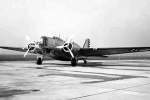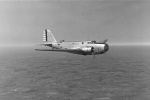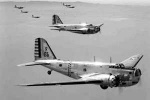
|
John A. Weeks III
Friday, January 9, 2026, 3:51:24 PM CST |
|||
| Home | Photo Tours | Rail Fan | 12 Easy Steps |
| Aviation | Spacecraft | Highways & Bridges | About The Author |

|
|
|||||||||||||||||
B-18 — The Bolo Survivors
The US military was in somewhat of tight situation with bomber aircraft
in the 1930s. War was looming in Europe, yet President Roosevelt had
promised the American people that the US would stay out of a European
war. The US Army Air Corps wanted to be ready if war did come, but
between Congress and the Great Depression, there simply was no money
for big new aircraft projects. There was a very real fear the that the
US would get caught up in the war unexpectedly, and be years behind the
technology curve in aircraft just like the US had been when it entered WWI.
The bomber that the USAAC did have was the B-10. While the B-10 was a marvel in the early 1930s in that it flew faster than any fighter aircraft in the inventory, rapidly evolving technology left the B-10 as an obsolete sitting duck by the mid-1930s. The Army issues a request for new bombers. Martin submitted the model 146, an up-rated B-10. Boeing submitted the model 299, the aircraft that would become the B-17. Douglas adapted the DC-2 commercial airliner as the DB-1 bomber. In the competition to evaluate these prototypes, the Martin entry was quickly dropped. It offered little better performance than the B-10, and it showed little room for growth. The Boeing 299 looked great, but it crashed during the program, resulting in it being eliminated from the competition. The Douglas bomber was the last entry in the race. It was clearly inferior in every respect. It was slow, had a small bomb load, it has little in the way of defensive armaments, and little armour plating. But it was available, and it was cheap. As a result, Congress approved the purchase of the Douglas DB-1 as the B-18 Bolo.



The B-18 enter service in 1937. Its deficiencies were becoming apparent to the USAAC, who determined that sending a B-18 on a long range bombing mission against a defended target would be suicidal. At the same time that the B-18 was approved, a second test of the Boeing 299 was funded, allowing the Army to essentially sneak the B-17 in through the back door. As was predicted, the US ended up entering WWII in December of 1941. The B-10 and B-18 were deployed across the Pacific and on the mainland. As was predicted, nearly all of the B-10 and B-18 were wiped out by the Japanese in the Pacific, and those that survived proved to be ineffective. The Army did not want to send the B-18 to war, but it was the only bomber that they had in quantity. Over time, the B-17 and later the B-24 became available in quantity, plus there were a number of excellent medium bombers such as the B-25 and B-26. The result is that the B-18 spent the first two years of the war on a training mission or anti-submarine patrol, then spent two more years as light transports and base hack aircraft. The B-18 was mostly retired from duty by 1945. The B-18 wasn't the best looking airplane in WWII. Nor was it the fastest or the biggest, or even a very useful airplane. But it was cheap, and it was available early in the war when it was essentially the only bomber in the inventory that was ready to go. While that might sound like faint praise, the B-18 and her crews did their job knowing that they were outclassed by technology and helped to hold the line on the Japanese and Germans until modern equipment could make it to the front lines. Known B-18 Bolo Survivors
Note — click on the Serial Number to see a photo of each airplane.
|
|
|
Authored by John A. Weeks III, Copyright © 1996—2016, all rights reserved. For further information, contact: john@johnweeks.com
|